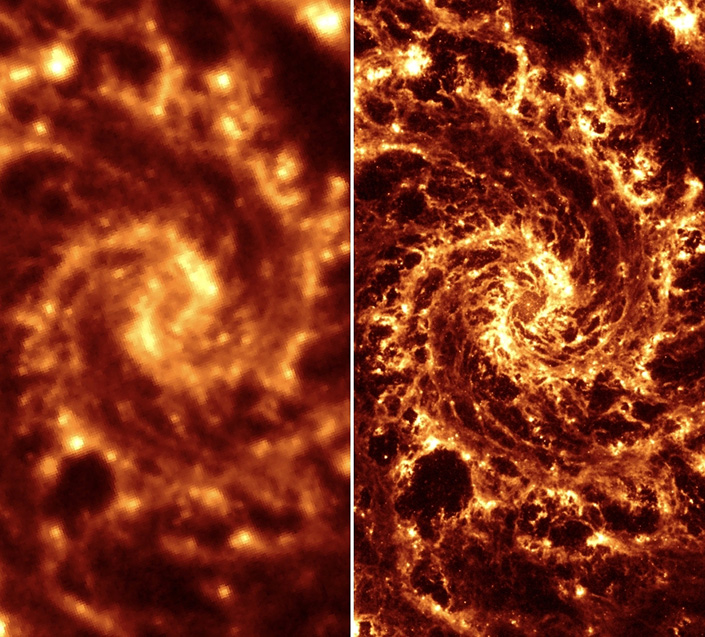A Star is Born: Images of Nearby Galaxies Provide Clues About Star Formation
UC San Diego researchers use advanced telescope to study the smallest dust particles of the interstellar medium
Story by:
Published Date
Article Content
It is a popular notion that aside from large celestial objects like planets, stars and asteroids, outer space is empty. In fact, galaxies are filled with something called the interstellar medium (ISM) — that is, the gas and dust that permeate the space in between those large objects. Importantly, under the right conditions, it is from the ISM that new stars are formed.
Now researchers from the University of California San Diego, in collaboration with a worldwide project team, have released their findings in a special issue of The Astrophysical Journal Letters dedicated to their work using advanced telescope images through the JWST Cycle 1 Treasury Program.
“With JWST, you can make incredible maps of nearby galaxies at very high resolution that provide amazingly detailed images of the interstellar medium,” stated Associate Professor of Physics Karin Sandstrom who is a co-principal investigator on the project.
Although JWST can look at very distant galaxies, the ones Sandstrom’s group studied are relatively close at about 30 million light years away, including one known as the Phantom Galaxy. Also known as M74 or NGC 628, astronomers have known of the Phantom Galaxy’s existence since at least the 18th century.
Sandstrom, along with postdoctoral scholar Jessica Sutter and former postdoctoral scholar Jeremy Chastenet (now at University of Ghent), focused on a specific component of the ISM called polycyclic aromatic hydrocarbons (PAHs). PAHs are small particles of dust — the size of a molecule — and it’s their small size that makes them so valuable to researchers.
When PAHs absorb a photon from a star, they vibrate and produce emission features that can be detected in the mid-infrared electromagnetic spectrum — something that typically doesn’t happen with larger dust grains from the ISM. The vibrational features of PAHs allow researchers to observe many important characteristics including size, ionization and structure.
This is something Sandstrom has been interested in since graduate school. “The Spitzer Space Telescope looked at the mid-infrared and that's what I used in my Ph.D. thesis. Since Spitzer was retired, we haven't had much access to the mid-infrared spectrum, but JWST is incredible,” she stated. “Spitzer had a mirror that was 0.8 meters; JWST’s mirror is 6.5 meters. It's a huge telescope and it has amazing instruments. I've been waiting a very long time for this.”
Even though PAHs are not by mass a big fraction of the overall ISM, they're important because they’re easily ionized — a process that can produce photoelectrons which heat the rest of the gas in the ISM. A better understanding of PAHs will lead to a better understanding of the physics of the ISM and how it operates. Astrophysicists are hopeful JWST can provide a view into how PAHs are formed, how they change and how they’re destroyed.
Because PAHs are evenly distributed throughout the ISM, they allow researchers to see not just the PAHs themselves, but everything around them as well. Previous maps, such as ones taken by Spitzer, contained much less detail — they essentially looked like galactic blobs. With the clarity JWST provides, astrophysicists can now see gas filaments and even “bubbles” blown by newly formed stars, whose intense radiation fields and resulting supernova evaporate the gas clouds around them.
To get observation time on JWST, the Cycle 1 Treasury Program team had to design observations that included details such as exposure length and filters. Once their submission was accepted, Space Telescope Science Institute, which is responsible for the science and mission operations for JWST, captures and processes the data. This program includes data from 19 galaxies in total.

The Cycle 1 Treasury Program is part of a bigger project called PHANGS (Physics at High Angular Resolution in Nearby GalaxieS). PHANGS studies star formation and the ISM using multi-wavelength images from the Atacama Large Millimeter Array (ALMA) and the Very Large Telescope, both in Chile. However, because the dense clouds in which star formation happens contain a lot of dust, it is difficult for optical light to penetrate to see what's happening inside. Using the mid-infrared spectrum allows researchers to use that same dust and its bright emission to get high-resolution, detailed images.
“One of the things I'm most excited about is now that we have this high-resolution tracer of the ISM, we can map all kinds of things, including the structure of the diffuse gas, which has to become denser and molecular for star formation to occur,” said Sandstrom. “We can also map the gas surrounding newly formed stars where there is a lot of ‘feedback’ such as from supernova explosions. We really get to see the whole cycle of the ISM in a lot of detail. That is the core of how a galaxy is going to form stars.”
This work is supported by Space Telescope Science Institute (JWST-GO-02107.006-A).
Share This:
You May Also Like
UC San Diego is Strengthening U.S. Semiconductor Innovation and Workforce Development
Technology & EngineeringStay in the Know
Keep up with all the latest from UC San Diego. Subscribe to the newsletter today.




